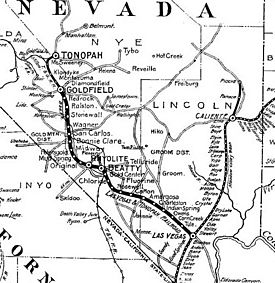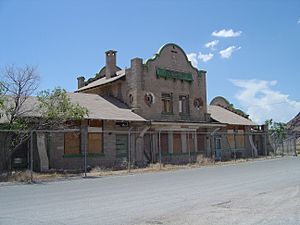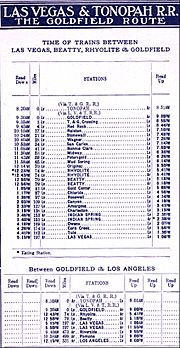Las Vegas and Tonopah Railroad facts for kids
 |
|

Map showing the route of the LV&&T.
|
|
| Overview | |
|---|---|
| Headquarters | Los Angeles, California |
| Reporting mark | LV&T |
| Locale | Las Vegas to Goldfield, Nevada |
| Dates of operation | 1906–1918 |
| Technical | |
| Track gauge | 4 ft 8 1⁄2 in (1,435 mm) standard gauge |
The Las Vegas and Tonopah Railroad was a railway line that stretched about 198 miles (319 km) across Nevada. It was built by a man named William A. Clark. This railroad connected Las Vegas, Nevada, to the rich gold mines in Goldfield. It started by linking up with another big railroad, the San Pedro, Los Angeles and Salt Lake Railroad. This older railroad later became part of the famous Union Pacific Railroad.
Contents
History of the Las Vegas and Tonopah Railroad
In April 1905, William A. Clark and Francis Marion Smith had a spoken agreement. Smith was supposed to build a railway line to his borax mines at Lila C, California. This new line would connect to Clark's San Pedro, Los Angeles and Salt Lake Railroad in Las Vegas.
However, things didn't go as planned. After Smith's workers had already prepared about 12 miles (19 km) of land for the tracks, they were told to stop. Clark had changed his mind. He then built his own railway on the land Smith's men had already prepared! Because of this, Smith started his own competing railway, called the Tonopah and Tidewater Railroad. This new line also aimed for the busy gold towns, directly competing with Clark's plans.
Building the Railway Line
The Las Vegas and Tonopah Railroad company was officially created on September 22, 1905. The first part of the track, from Las Vegas to Indian Springs, was finished by March 1, 1906. By the middle of 1906, more than half of the line was done, reaching Rose's Well.
In December 1906, the tracks arrived at Rhyolite, a famous mining town. Finally, in November 1907, the entire 198-mile (319 km) railway was open. It ran all the way from Las Vegas to Goldfield.
When the Railway Closed
The northern part of the line, from Beatty to Goldfield, was only used for a short time, from 1908 to 1914. About 80 miles (129 km) of this track was removed during World War I. The Las Vegas & Tonopah continued to serve the Bullfrog Mining District near Beatty until 1917 or 1918. By 1919, the remaining 110 miles (177 km) of track were taken up and sold for scrap.
How the Trains Operated
In 1906, a trip from Las Vegas to Beatty, which was about 118 miles (190 km), took 6 hours. Trains ran every day until February 1, 1917. After that, they ran only three times a week until the railway was closed.
The old train station (depot) in Rhyolite is still standing today. It was built in 1909 and cost $130,000 at the time.
Locomotives (Train Engines)
The Las Vegas and Tonopah Railroad mainly used two types of steam locomotives:
- "Ten Wheeler" (4-6-0 type)
- "Consolidation" (2-8-0 type)
These engines were mostly made by Brooks and Baldwin Locomotive Works. The railroad bought its first four engines used. Later, they bought 12 more brand-new locomotives. When the railroad closed in 1917-1918, these engines were sold to other railway companies.
In 1914, the LV&T joined with the Bullfrog Goldfield Railroad. This meant the LV&T also got 6 more steam locomotives from that merger. These included smaller 0-6-0 engines for switching cars, 4-6-0 engines for passenger trains, and 2-8-0 engines for freight trains.
Preservation Efforts
A group called the Los Angeles Live Steamers once owned an old wooden passenger car. They named it "Tonopah" and thought it was from the Las Vegas & Tonopah Railroad. However, it was later confirmed that the car actually came from the Tonopah and Tidewater Railroad. So, it never actually ran on the LV&T line.
Route of the Railway
Here are some of the main stops along the Las Vegas and Tonopah Railroad line:
- Las Vegas (Mile Post 0.0)
- Tule
- Corn Creek
- Owens
- Indian Springs (Mile Post 43.0)
- Charleston (possibly named after nearby Mount Charleston)
- Amargosa (Mile Post 74.0)
- Cañon
- Rosewell (Rose's Well) (Mile Post 100.0)
- Chloride
- Beatty (Mile Post 118.4)
- Rhyolite (Mile Post 123.4), with a side track to the Montgomery-Shoshone Mine.
- Original
- Mud Springs
- Midway
- Bonnie Claire
- Wagner
- Stonewall
- Ralston (possibly named after Ralston Valley)
- Red Rock
- Milltown
- Columbia
- Goldfield (Mile Post 196.9)



